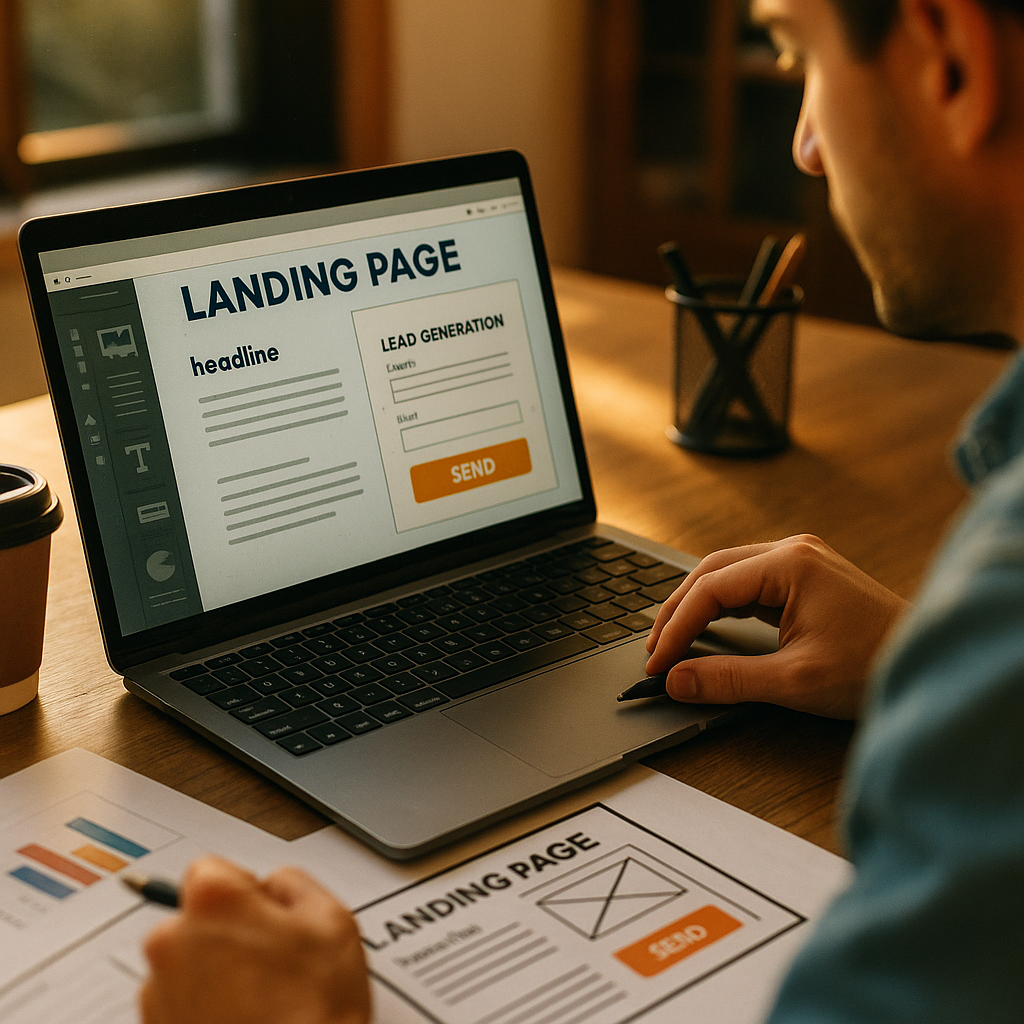B2B marketers understand the critical role a high-converting B2B lead generation landing page plays in fueling sales pipelines. But what separates average landing pages from those that consistently drive qualified leads? In this deep dive, we explore the proven principles that power exceptional conversion rates—so you can create your own lead-generating masterpiece.
The Essentials of a B2B Landing Page Layout
Structuring your landing page with clarity and purpose is the foundation for successful B2B lead generation. A well-defined layout ensures visitors immediately grasp your offering and the value you provide. Start with a persuasive headline that addresses your audience’s pain point. This should be followed by a concise, benefit-driven subheadline. High-impact visuals, such as industry-relevant hero images or short explainer videos, help communicate complex solutions quickly.
Keep navigation minimal to reduce distractions—ideally, remove main menu links. Prominently position your lead capture form above the fold. Balance content and white space to guide the eye and maintain a professional, trustworthy appearance, essential for building confidence with business decision-makers.
Crafting Irresistible Value Propositions for Better Lead Quality
Your value proposition is the focal point of your B2B landing page. It must differentiate your solution and resonate with your target audience’s specific challenges. According to a 2025 HubSpot survey, B2B buyers respond best to clear, solution-oriented messaging showing measurable ROI. Articulate your unique benefits succinctly, and avoid jargon that may confuse or alienate first-time visitors.
Reinforce your value with relevant features, use cases, or product screenshots. For maximum impact, emphasize outcomes—how does your offering drive efficiency, cut costs, or deliver strategic advantage? A strong, focused value proposition attracts high-intent leads and filters out unqualified ones, improving sales productivity down the line.
Building Trust and Credibility with Social Proof
B2B buyers are risk-averse and require reassurance before sharing their details. Integrating robust social proof establishes the trust essential for conversion. Feature testimonials from industry leaders, logos of recognizable client brands, or third-party analyst endorsements. Whenever possible, provide specific metrics—such as, “Our software reduced acquisition costs by 30% for TechGlobal.”
Case studies, awards, and certifications add authenticity. Display real customer photos for extra credibility. A recent Demand Gen Report (2025) states that B2B buyers are 2.4x more likely to convert when landing pages show authentic social proof. Make this content visible near your lead capture form to amplify impact during decision moments.
Optimizing Forms for Maximum Lead Capture Efficiency
The lead capture form is the conversion engine of your landing page. The key is to maximize completion rates without sacrificing lead quality. Keep forms short—request only essential information, such as business email, company name, and role. A LinkedIn Research report in 2025 found that B2B forms with three or fewer fields boost conversion rates by 27% compared to longer forms.
Use progressive profiling to gather additional details on subsequent interactions. Offer assurances of data privacy and compliance (e.g., GDPR, CCPA) with concise, clickable privacy statements. Experiment with single-step versus multi-step forms, and highlight a compelling call-to-action (CTA) button with action-oriented copy, such as “Get My Free Demo” or “Access the Guide.” Remove friction wherever possible—auto-fill capabilities and mobile responsiveness are must-haves.
A/B Testing and Continuous Performance Improvement
No high-converting B2B landing page is ever truly finished. The most successful marketers treat optimization as an ongoing process. Leverage A/B testing to refine messaging, CTA text, imagery, and form lengths. Track key performance indicators (KPIs) such as conversion rates, bounce rates, lead quality, and cost per lead with a robust analytics suite.
Solicit buyer feedback directly to uncover potential friction points. Continually adapt to changes in customer priorities, competitive messaging, and evolving industry regulations. Staying vigilant with incremental improvements is vital for keeping your conversion rates at the top tier, no matter how dynamic the B2B landscape becomes in 2025 and beyond.
Mobile Responsiveness: Reaching Decision Makers Everywhere
Today’s B2B decision-makers expect seamless experiences across devices. According to Statista, over 62% of B2B buyers in 2025 conduct research on mobile devices at some stage in the buying process. Ensuring your landing page loads quickly, displays correctly on all screen sizes, and allows for effortless form submission on mobile is non-negotiable.
Test every element—from CTA buttons to downloadable assets—to confirm mobile usability. Prioritize fast load times (ideally under two seconds) and leverage responsive design frameworks. By removing barriers for mobile users, you open your funnel to more high-value leads, regardless of how or where they first engage with your brand.
Conclusion: Your Blueprint for Consistent B2B Lead Generation Success
A high-converting B2B lead generation landing page is the result of careful design, strategic messaging, and relentless optimization. By implementing these core principles—from compelling layouts to social proof and ongoing testing—you create landing pages that capture, qualify, and convert your most valuable prospects every time.
FAQs: High-Converting B2B Lead Generation Landing Pages
-
What is the most important element of a B2B lead generation landing page?
The most critical element is a clear, compelling value proposition that directly addresses your audience’s needs, supported by a strong call-to-action and credible social proof.
-
How many form fields should I include for optimal conversions?
Start with three or fewer fields to maximize completion rates. Request only essential business information and consider gathering more details in subsequent steps.
-
Why is social proof so important in B2B?
B2B buyers are often cautious and require validation. Social proof—like testimonials, recognizable client logos, or measurable results—demonstrates credibility and reassures prospects that your offer is proven.
-
How often should I update or test my landing page?
Continuous improvement is key. Schedule regular A/B tests and review analytics monthly to refine your landing page and keep pace with evolving buyer expectations and industry trends.
-
Is mobile optimization really necessary for B2B audiences?
Yes—over half of B2B research now happens on mobile. Ensuring your landing page is fast, responsive, and easy to navigate increases your lead pool and can significantly lift conversion rates.
